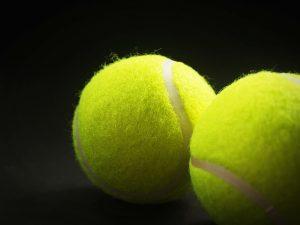We may earn money or products from the companies mentioned in this post.
Introduction

Tennis strings may seem like a small and insignificant part of the game, but they play a crucial role in determining the performance and feel of a tennis racket From power to spin and control, the type of strings you use can significantly impact your gameplay Additionally, maintaining proper string tension and performance is essential for achieving consistent results on the court
Importance of tennis strings in the game
When it comes to playing tennis, every aspect counts – including the choice of strings The strings on a tennis racket are responsible for transferring energy from your swing into the ball, affecting power, spin, and control
Power: The right strings can enhance your shots by adding extra pop to your strokes Softer strings tend to provide more power as they have greater elasticity, while stiffer ones offer better control but sacrifice some power
Spin: Spin is an integral part of modern tennis Strings with textured surfaces or greater bite can generate more spin on the ball, allowing you to hit shots with incredible topspin or slice
Control: Precision and accuracy are vital in any player’s arsenal Strings with less elasticity offer better control over ball placement, enabling you to hit shots exactly where you want them
What are “dead” tennis strings?
Have you ever experienced a sudden drop in performance despite no visible damage to your tennis racket? You might be dealing with “dead” strings Dead strings refer to those that have lost their original tension and responsiveness due to wear and tear or prolonged use
Characteristics: Dead strings often feel lifeless and lack resilience when struck by the ball They lose their ability to provide optimal power, control, and spin due to decreased tension and elasticity
Impact on gameplay: Playing with dead strings can be frustrating as it alters your shot-making capabilities Your shots may lack power and depth while also struggling to generate spin Moreover, dead strings can affect your timing and overall feel for the ball, leading to inconsistent performance on the court
In conclusion, tennis strings are an integral part of the game, affecting power, spin, and control It is crucial to maintain string tension and replace dead strings regularly to ensure optimal performance By understanding the importance of tennis strings, you can make informed decisions about string selection and maximize your potential on the court
Signs that your tennis strings are dead

As a tennis player, it’s important to recognize when your tennis strings have reached the end of their lifespan Dead strings can significantly impact your game, affecting your control, power, and overall performance on the court Here are some key signs to look out for:
Loss of tension
One of the first indicators that your tennis strings are dead is a noticeable loss of tension When strings lose their tension, you may experience difficulty in maintaining consistent ball control or direction Shots that used to be precise and accurate may start flying off course, leading to frustration and inconsistency in your game Additionally, you might notice a sudden change in power levels while hitting the ball, as the lack of tension affects the transfer of energy between the racket and the ball
Reduced elasticity and responsiveness
Another sign that your tennis strings are reaching their expiration date is a decrease in elasticity and responsiveness When strings lose their bounce, it can greatly impact shot accuracy The ball may feel dead upon contact with the racket, resulting in shots that lack depth or penetration Furthermore, reduced string elasticity can lead to a loss of spin generation, making it harder to execute topspin or slice shots effectively
String movement and spacing issues
If you find yourself constantly needing to straighten out your tennis strings during play, it’s a clear indication that they are losing their life span Dead strings tend to move around more within the racket’s string bed due to decreased tension and lack of grip on each other This movement can affect shot consistency and control since you won’t have a stable string surface to make clean contact with the ball
Frequent string breaks can also be an indicator of worn-out or dying strings If you notice that your strings are breaking more often than usual, it’s a sign that they have lost their durability and quality This can be frustrating, as it means you’ll have to replace your strings more frequently to maintain optimal performance
Visual cues
Visually inspecting your tennis strings can also provide insights into their condition Look out for fraying or notching at the contact points with the ball, typically located in the sweet spot area of the racket These signs of wear and tear indicate that your strings have been subjected to significant stress and are no longer capable of providing the necessary power and control during play
It’s worth noting that wear patterns on your strings can also give clues about your playing style For example, heavy topspin players may notice more fraying on the top side of their strings due to excessive brushing against the ball’s spin
In conclusion, recognizing the signs of dead tennis strings is crucial for maintaining a consistent and effective game on the court Loss of tension, reduced elasticity, string movement issues, and visual cues like fraying or notching are all indicators that it’s time to restring your racket By staying vigilant and replacing worn-out strings promptly, you can ensure optimal performance and enjoy a better playing experience overall
How to Test If Your Tennis Strings Are Dead

Tennis strings are an essential component of your racket, and over time, they can lose their tension and become less effective But how do you know when it’s time to replace them? Here are two simple tests you can perform to determine if your tennis strings are dead
Water Droplet Test
The water droplet test is a quick and easy way to assess the condition of your tennis strings To perform this test:
- Take a small droplet of water and place it on the center of your racket strings
- Observe how the droplet behaves when it hits the strings
If the water droplet spreads out evenly across the strings and remains stable, it indicates that your strings still have good tension On the other hand, if the droplet sinks into or slides off the strings quickly, it suggests that they have lost their elasticity and need replacing
Playtesting Techniques for Experienced Players
If you’re an experienced player, you can also rely on your own senses to determine if your tennis strings are dead Here are two playtesting techniques you can use:
-
Listening for Changes in Sound:
When hitting the ball with dead strings, you may notice a duller sound upon impact compared to lively and responsive strings Pay attention to any changes in sound during gameplay as this can be an indication that your strings need replacing -
Paying Attention to Discomfort or Changes in Playing Technique:
As players become accustomed to their racket’s feel with fresh strings, any discomfort or significant changes in playing technique could suggest that the tension has decreased over time If you find yourself struggling to generate power or control, it may be time for a restring
By performing these simple tests and paying attention to the signs, you can ensure that your tennis strings are in optimal condition for peak performance on the court Remember, regularly checking and replacing your strings will help maintain consistency and enhance your overall playing experience
Preventing dead strings and prolonging string life
When it comes to maximizing the lifespan of your tennis racket strings, there are several factors to consider One of the most important aspects is choosing the right string type that suits your playstyle You have options like natural gut, synthetic gut, multifilament, and monofilament strings
Natural gut vs synthetic gut, multifilament vs monofilament
Natural gut strings offer exceptional comfort and feel due to their elasticity They provide excellent power and control but tend to be less durable compared to synthetic gut or other types On the other hand, synthetic gut strings are more resistant to moisture and can last longer
In terms of construction, multifilament strings consist of multiple fibers woven together They offer a softer feel and enhanced playability but may not be as durable as monofilament strings which are made from a single solid core
Advantages/disadvantages based on durability, spin, control, etc
The choice between different string types also depends on factors like durability, spin potential, and control Synthetic gut or monofilament strings generally provide better durability compared to natural gut or multifilaments If you’re looking for increased spin potential or control over your shots, certain string types may suit your needs better than others
String gauge selection

The gauge refers to the thickness of tennis racket strings Different gauges are available in the market ranging from thinner gauges (eg, 18-20) to thicker ones (eg, 15-16). The appropriate gauge choice depends on finding the right balance between power, spin generation, and durability
Explanation of different gauges available
Thinner gauge strings provide more ball bite and spin potential due to their increased surface area However, they tend to be less durable compared to thicker gauges Thicker gauge strings offer better durability and control but may sacrifice some spin potential
Balancing power, spin, and durability with appropriate gauge choice
Choosing the right string gauge involves finding a balance between power, spin, and durability based on your playing style and preferences If you’re an aggressive player who relies on power shots, a thinner gauge might be suitable Alternatively, if you prioritize control and longevity, opting for a thicker gauge could be the way to go
Proper string tension range for your racquet and playing style

The tension of your tennis racket strings plays a significant role in your overall performance on the court Different tensions can have varying effects on power, control, and feel
Impact of different tensions on performance
A higher string tension generally results in increased control but reduced power Conversely, a lower tension offers more power but less precision Finding the ideal tension range depends on factors like your playstyle, skill level, and personal preference
Considerations for adjusting tension based on ability, conditions, etc
It’s important to consider factors such as your ability level and playing conditions when determining string tension adjustments Experienced players may opt for higher tensions to enhance control while beginners or those seeking more power might prefer lower tensions Additionally, external factors like temperature and humidity can also impact string tension
Regularly restringing your racquet

To maintain optimal performance and prolong the life of your tennis racket strings, regular restringing is essential
-
Factors that influence frequency of restringing:
- Duration and intensity of play: If you play frequently or engage in intense matches, your strings may wear out faster
- Climate and storage conditions: Extreme temperatures or improper storage can impact the lifespan of your strings
-
How to know when it’s time to restring: guidelines and recommendations
While there isn’t a set timeframe for restringing, certain signs indicate that it’s time for a fresh set of strings These signs include noticeable loss of tension, visible fraying or breaking, reduced performance, or decreased feel during gameplay It’s important to consult with a professional stringer who can offer personalized recommendations based on your playing habits and needs
Useful Links

When do you know to change your tennis strings?
Strings (tennis)
Basic facts about tennis racquet strings
Stringing
String Tension
Tennis Raquet Physics
How often should you Change Tennis Strings?
How Often Should You Restring Your Tennis Racquet?
Is My String Dead?
Warning: Improper Use of This String May be Hazardous to …
How often should you restring your tennis racket?
Restringing – Mission Tennis
▷ When Should You Change Your Tennis Strings?【2021】
How to choose the right tennis strings
Lifestyles Sports – Did you know we restring Tennis …
When to restring your racket
The Different Causes Of Dead Guitar Strings (And How To …
Do you break strings?






